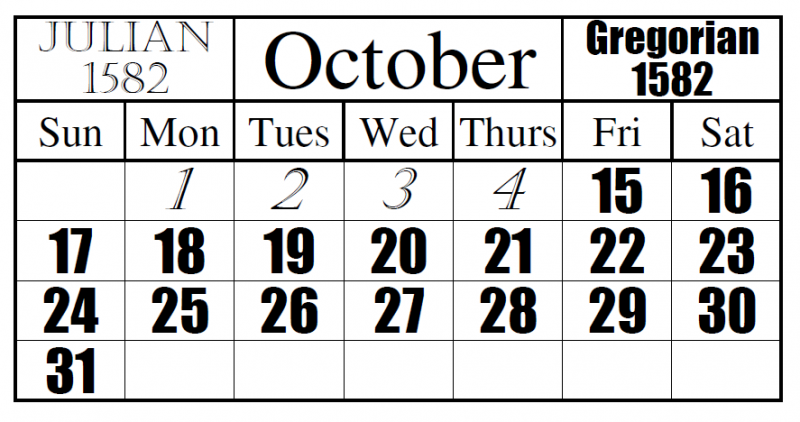
Today’s date – January 13, 2021 – might be just another Wednesday in the Gregorian calendar, the one that pops up on your phone or laptop. But it’s the last day of the year by the old Julian calendar, which was first introduced to the world by Julius Caesar in 46 B.C. Today is the Julian New Year, sometimes called the Old New Year or the Orthodox New Year.
Tomorrow – January 14, 2021 – will be January 1 in the Julian calendar.
Best New Year’s gift ever! EarthSky moon calendar for 2021. Only a few left.
Historians and other chronologists care about the Julian calendar because it was used worldwide for over 16 centuries. Some – for example, the Christian Eastern Orthodox Church – still use the Julian calendar to this day.
But most of us don’t use it. After the inception of the Gregorian calendar on October 15, 1582, more and more people slowly but surely came to adopt the Gregorian calendar, which is now used nearly everywhere worldwide.
For astronomers and astronomy enthusiasts, it’s good to know that chronologists use the Julian calendar date for dates of celestial events occurring before the Gregorian calendar was introduced. For instance, equinoxes and solstices and any lunar and solar eclipses happening before October 15, 1582, are dated by the Julian calendar.
The transition from Julian calendar to Gregorian calendar wasn’t quick or easy, but the more accurate Gregorian calendar ultimately prevailed. In the old calendar system, there was an accumulated discrepancy between the calendar dates and the actual time of the Northern Hemisphere’s spring equinox. Pope Gregory decreed that October 4, 1582, on the Julian calendar was to be followed by October 15, 1582, in the newly established Gregorian calendar.
That transition is illustrated by the calendar below:

When the world began its transition from the old-style Julian calendar to the newly established Gregorian calendar, some calendar dates had to disappear. Pope Gregory decreed that the Julian date October 4, 1582, was to be followed by the Gregorian date October 15, 1582.
Not everyone converted to the new calendar at the same time. England, for example, with its large empire and separate church kept its separate calendar, too – the Julian calendar – for another two centuries. But, as explained on MentalFloss.com:
… it all got rather confusing: People often headed up letters they wrote with two dates – one using the new Gregorian calendar in fashion in mainland Europe, and the other using the old-fashioned Julian calendar.
Eventually, Britain adopted the newer Gregorian calendar – the calendar we use today – with its Calendar (New Style) Act of 1750. According to some, that adoption prompted the English calendar riots of 1752, during which people supposedly shouted:
Give us our 11 days!
Meanwhile, others say the English calendar riots are a myth.

View larger. | Painting by William Hogarth, ca. 1755, includes the famous protest slogan against the Gregorian calendar: “Give us our 11 days.” It’s at the lower right (on black banner on floor under foot). Image via Wikimedia Commons.
Here’s a bit more about why the new Gregorian calendar was so sorely needed. The Northern Hemisphere’s spring equinox – a nature event, in which the sun is directly above Earth’s equator, moving from south to north – falls on or near March 21 every year. However, the discrepancy between the Julian calendar and the spring equinox put the calendar out of step with the seasons. By the year 1582, for instance, the spring equinox came on March 10 by the Julian calendar. Without calendar reform, the spring equinox date would have moved into February, and then January, and then December …
The old-style Julian calendar declared every fourth year a leap year of 366 days. This made the average length of the Julian year 365.25 days, which is about 11 minutes too long relative to the year as measured by the spring equinox.
Eleven minutes doesn’t sound like much. But over the long period of time – over centuries and millennia – the cumulative error of one day in about 128 years is difficult to ignore.
The Gregorian calendar tweaked the rules a bit, to bring the calendar in closer agreement with the seasonal year. Century years which are not equally divisible by 400 are not considered leap years, in the Gregorian calendar. The year 2000 was a leap year, and the year 2400 will be a leap year, but the years 2100, 2200 and 2300 will be common years of 365 days.
Click here for Fourmilab’s calendar converter
Bottom line: January 13, 2021, marks the last day of the year in the Julian calendar. This post explains why we switched from this calendar. Happy Julian New Year!
from EarthSky https://ift.tt/30hudPG

Today’s date – January 13, 2021 – might be just another Wednesday in the Gregorian calendar, the one that pops up on your phone or laptop. But it’s the last day of the year by the old Julian calendar, which was first introduced to the world by Julius Caesar in 46 B.C. Today is the Julian New Year, sometimes called the Old New Year or the Orthodox New Year.
Tomorrow – January 14, 2021 – will be January 1 in the Julian calendar.
Best New Year’s gift ever! EarthSky moon calendar for 2021. Only a few left.
Historians and other chronologists care about the Julian calendar because it was used worldwide for over 16 centuries. Some – for example, the Christian Eastern Orthodox Church – still use the Julian calendar to this day.
But most of us don’t use it. After the inception of the Gregorian calendar on October 15, 1582, more and more people slowly but surely came to adopt the Gregorian calendar, which is now used nearly everywhere worldwide.
For astronomers and astronomy enthusiasts, it’s good to know that chronologists use the Julian calendar date for dates of celestial events occurring before the Gregorian calendar was introduced. For instance, equinoxes and solstices and any lunar and solar eclipses happening before October 15, 1582, are dated by the Julian calendar.
The transition from Julian calendar to Gregorian calendar wasn’t quick or easy, but the more accurate Gregorian calendar ultimately prevailed. In the old calendar system, there was an accumulated discrepancy between the calendar dates and the actual time of the Northern Hemisphere’s spring equinox. Pope Gregory decreed that October 4, 1582, on the Julian calendar was to be followed by October 15, 1582, in the newly established Gregorian calendar.
That transition is illustrated by the calendar below:

When the world began its transition from the old-style Julian calendar to the newly established Gregorian calendar, some calendar dates had to disappear. Pope Gregory decreed that the Julian date October 4, 1582, was to be followed by the Gregorian date October 15, 1582.
Not everyone converted to the new calendar at the same time. England, for example, with its large empire and separate church kept its separate calendar, too – the Julian calendar – for another two centuries. But, as explained on MentalFloss.com:
… it all got rather confusing: People often headed up letters they wrote with two dates – one using the new Gregorian calendar in fashion in mainland Europe, and the other using the old-fashioned Julian calendar.
Eventually, Britain adopted the newer Gregorian calendar – the calendar we use today – with its Calendar (New Style) Act of 1750. According to some, that adoption prompted the English calendar riots of 1752, during which people supposedly shouted:
Give us our 11 days!
Meanwhile, others say the English calendar riots are a myth.

View larger. | Painting by William Hogarth, ca. 1755, includes the famous protest slogan against the Gregorian calendar: “Give us our 11 days.” It’s at the lower right (on black banner on floor under foot). Image via Wikimedia Commons.
Here’s a bit more about why the new Gregorian calendar was so sorely needed. The Northern Hemisphere’s spring equinox – a nature event, in which the sun is directly above Earth’s equator, moving from south to north – falls on or near March 21 every year. However, the discrepancy between the Julian calendar and the spring equinox put the calendar out of step with the seasons. By the year 1582, for instance, the spring equinox came on March 10 by the Julian calendar. Without calendar reform, the spring equinox date would have moved into February, and then January, and then December …
The old-style Julian calendar declared every fourth year a leap year of 366 days. This made the average length of the Julian year 365.25 days, which is about 11 minutes too long relative to the year as measured by the spring equinox.
Eleven minutes doesn’t sound like much. But over the long period of time – over centuries and millennia – the cumulative error of one day in about 128 years is difficult to ignore.
The Gregorian calendar tweaked the rules a bit, to bring the calendar in closer agreement with the seasonal year. Century years which are not equally divisible by 400 are not considered leap years, in the Gregorian calendar. The year 2000 was a leap year, and the year 2400 will be a leap year, but the years 2100, 2200 and 2300 will be common years of 365 days.
Click here for Fourmilab’s calendar converter
Bottom line: January 13, 2021, marks the last day of the year in the Julian calendar. This post explains why we switched from this calendar. Happy Julian New Year!
from EarthSky https://ift.tt/30hudPG


Aucun commentaire:
Enregistrer un commentaire